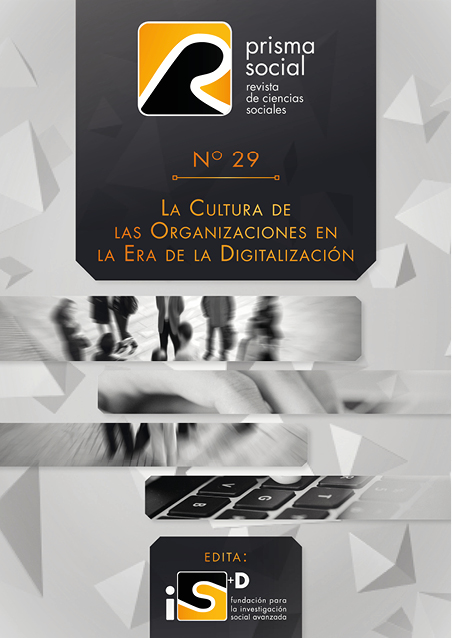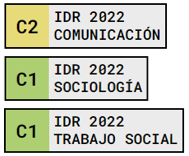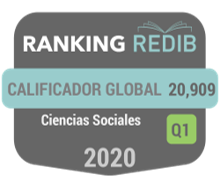¿Por qué los y las jóvenes están en las redes sociales? Un análisis de sus motivaciones a partir de la teoría de usos y gratificaciones
Keywords:
redes sociales, jóvenes universitarios, usos y gratificaciones, motivacionesAbstract
Young people spend a great part of their time on their social media profiles where they deploy diverse and changing performances. From the uses and gratifications theory, this article examines what undergraduates from the center of Argentina do on their favourite social media. Using a mixed methodology that combines quantitative and qualitative data obtained from a survey (n=1243) and semistructured interviews (n=132), results of this study indicate that the group behave differently on each digital platform and this is influenced by their motivation of satisfying diverse social and personal needs, such being in communication, getting informed, knowing what their contacts do and promoting a narcissist and happy version of their lives. Moreover, these uses are in relation to each social media architecture.
Downloads
References
Aizenkot, D. y Kashy-Rosenbaum, G. (2018). Cyberbullying in WhatsApp classmates’ groups: Evaluation of an intervention program implemented in Israeli elementary and middle schools. New Media and Society, 20(12), 4709–4727. DOI: 10.1177/1461444818782702
Alhabash, S. y Ma, M. (2017). A Tale of Four Platforms: Motivations and Uses of Facebook, Twitter, Instagram, and Snapchat Among College Students? Social Media and Society, 3(1), 1-13. DOI: 10.1177/2056305117691544
Almansa-Martínez, A., Fonseca, O. y Castillo-Esparcia, A. (2013). Social networks and young people. Comparative study of facebook between Colombia and Spain. Comunicar, 20(40), 127–134. DOI: 10.3916/C40-2013-03-03
Anderson, M. y Jiang, J. (2018). Teens, Social Media y Technology 2018. Washington. Recuperado de: https://www.pewresearch.org/internet/2018/05/31/teens-social-media-technology-2018/ Último acceso: 25 de marzo de 2020
Antunovic, D., Parsons, P. y Cooke, T. R. (2018). ‘Checking’ and googling: Stages of news consumption among young adults. Journalism, 19(5), 632–648. DOI: 10.1177/1464884916663625
Bauman, Z. (2003). Modernidad líquida. Buenos Aires: Fondo de Cultura Económica.
Bruns, A. y Burgess, J. (2011). The use of Twitter hashtags in the formation of ad hoc publics. 6th European Consortium for Political Research General Conference (ECPR 2011), (August), 1–9.
Cabase. (2018). Internet Index. Buenso Aires. Recuperado de www.cabase.org.ar. Último acceso: 28 de marzo de 2020
Castells, M. (2012). Redes de Indignación y esperanza. Barcelona: Alianza Editorial.
Cetinkaya, L. (2017). An educational technology tool that developed in the natural flow of life among students: WhatsApp. Intenational Journal of Progressive Education, 13(2), 29–47. DOI: 10.1177/2056305117691544
Chen, G. M. (2011). Tweet this: A uses and gratifications perspective on how active Twitter use gratifies a need to connect with others. Computers in Human Behavior, 27(2), 755–762. DOI: 10.1016/j.chb.2010.10.023
De Casas-Moreno, P., Tejedor-Calvo, S. y Romero Rodríguez, L. M. (2018). Micronarrativas en Instagram: Análisis del storytelling autobiográfico y de la proyección de identidades de los universitarios del ámbito de la comunicación. Prisma Social, 20, 40–57. Recuperado de https://revistaprismasocial.es/article/view/2288
García-Ruiz, R., Tirado Morueta, R. y Hernando Gómez, A. (2018). Redes sociales y estudiantes: motivos de uso y gratificaciones. Evidencias para el aprendizaje. Aula Abierta, 47(3), 291 -298. DOI: 10.17811/rifie.47.3.2018.291-298
Giannino, M. (2016). The social network: the European commission’ decision on the Facebook/ WhatsApp merger case. Journal of Internet Law, 19(7), 1–20.
Gülnar, B., Balci, Ş. y Çakir, V. (2010). Motivations of Facebook, YouTube and similar web sites users. Bilig, 54(Junio), 161–184.
Gutiérrez-Rubí, A. (2018). Millenials en Uruguay. Valores, actitudes y comportamientos. Montevideo: Fundación Telefónica-Movistar.
Hootsuite. (2019). Digital 2019. Argentina. Disponible en https://es.slideshare.net/DataReportal/digital-2019-argentina-january-2019-v01 Último acceso: 28 de marzo de 2020
Igartua, J.J. y Rodríguez-De-Dios, I. (2016). Correlatos motivacionales del uso y la satisfacción con Facebook en jóvenes españoles. Cuadernos.info, (38), 107-119. doi: 10.7764/cdi.38.848
INDEC. (2019). Informes Técnicos Ciencia y tecnología. Acceso y uso de tecnologías de la información y la comunicación. Buenso Aires. Disponible en https://www.indec.gob.ar/uploads/informesdeprensa/internet_06_19CBA837FC38.pdf. Último Acceso 30 de marzo de 2020
Johnson, P. R., y Yang, S.-U. (2009). Uses and Gratifications of Twitter: An Examination of User Motives and Satisfaction of Twitter Use. Association for Education in Journalism and Mass Communication, (July). Recuperado de http://www.allacademic.com//meta/p_mla_apa_research_citation/3/7/6/3/6/pages376367/p376367-1.php
Katz, E., Blumler, J. G. y Gurevitch, M. (1973). Uses and Gratifications Research. Public Opinion Quarterly, 37(4), 509. DOI: 10.1086/268109
Kim, Y., Sohn, D. y Choi, S. M. (2011). Cultural difference in motivations for using social network sites: A comparative study of American and Korean college students. Computers in Human Behavior, 27(1), 365–372. DOI: 10.1016/j.chb.2010.08.015
Krause, A. E., North, A. C. y Heritage, B. (2014). The uses and gratifications of using Facebook music listening applications. Computers in Human Behavior, 39, 71–77. DOI: 10.1016/j.chb.2014.07.001
Lucas, K. y Sherry, J. L. (2004). Sex Differences in Video Game Play: Communication Research, 31(5), 499–523. DOI: 10.1177/0093650204267930
Maarek, P. J. (2014). Politics 2.0: New Forms of Digital Political Marketing and Political Communication. Trípodos, 34, 13–22.
Marcus, S. . (Mayo 2015). Picturing’ ourselves into being: assessing identity, sociality and visuality on Instagram. Conferencia presentada en International Communication Association Convention, San Juan, Puerto Rico
Martínez-Salgado, C. (2012). El muestreo en investigación cualitativa. Principios básicos y algunas controversias. Ciencia e Saude Coletiva, 17(3), 613–619. DOI: 10.1590/S1413-81232012000300006
Martínez Rolán, X. y Piñeiro-Otero, T. (2017). El uso de los memes en la conversación política 2.0: Una aproximación a una movilización efímera. Prisma Social, 18, 55–84. Recuperado de https://revistaprismasocial.es/article/view/2288
Matassi, M., Boczkowski, P. J. y Mitchelstein, E. (2019). Domesticating WhatsApp: Family, friends, work, and study in everyday communication. New Media y Society, 21(10), 2183–2200. DOI: 10.1177/1461444819841890
Mejía Navarrete, J. (2000). El muestreo en la investigación cualitativa. Investigaciones Sociales, 4(5), 165–180.
Molyneux, L. (2017). Mobile news consumption: A habit of snacking. Digital Journalism, 6 (5), 634-650, DOI:10.1080/21670811.2017.1334567.
Moon, J. H., Lee, E., Lee, J. A., Choi, T. R. y Sung, Y. (2016). The role of narcissism in self-promotion on Instagram. Personality and Individual Differences, 101, 22–25. DOI: 10.1016/j.paid.2016.05.042
Mull, I. R. y Lee, S.-E. (2014). “PIN” pointing the motivational dimensions behind Pinterest. Computers in Human Behavior, 33, 192–200. DOI: 10.1016/j.chb.2014.01.011
Newman, N., Richard Fletcher, W., Kalogeropoulos, A. y Kleis Nielsen, R. (2019). Reuters Institute Digital News Report 2019. Recuperado de: https://reutersinstitute.politics.ox.ac.uk/sites/default/files/2019-06/DNR_2019_FINAL_1.pdf. Último acceso 10 de enero de 2020
Oliva, A. (2019, 6 de Agosto). Dime qué edad tienes y te diré qué redes sociales usas. Cba24n. Recuperado de https://www.cba24n.com.ar/sociedad/dime-que-edad-tienes-y-te-dire-que-redes-sociales-usas_a5de57c1ed91dda4989140ed5. Último acceso 10 de enero de 2020
Parmelee, J. H. y Roman, N. (2019). Insta-Politicos: Motivations for Following Political Leaders on Instagram. Social Media + Society, 5(2), DOI:10.1177/2056305119837662
Resende, G., Messias, J., Silva, M., Almeida, J., Vasconcelos, M. y Benevenuto, F. (2018). A System for Monitoring Public Political Groups in WhatsApp. Proceedings of the 24th Brazilian Symposium on Multimedia and the Web, 387–390. https://doi.org/10.1145/3243082.3264662
Russmann, U. y Svensson, J. (2017). Introduction to Visual Communication in the Age of Social Media : Conceptual , Theoretical and Methodological Challenges, Cogitatio, 5(4), 1–5. DOI: 10.17645/mac.v5i4.1263
Sampietro, A. y Sánchez-Castillo, S. (2020). La promoción de la imagen política en Instagram: Un estudio del perfil personal de Santiago Abascal (Vox) en 2018. Communication y Society, 33(1), 169–184. DOI: 10.15581/003.33.1.169-184
Sheldon, P. y Bryant, K. (2016). Instagram: Motives for its use and relationship to narcissism and contextual age. Computers in Human Behavior, 58, 89–97. DOI:10.1016/j.chb.2015.12.059
Sistema de Información Cultural de la Argentina. (2017). Encuesta Nacional de Consumos Culturales. Encuesta Nacional de Consumos Culturales 2017. Recuperado de: //www.sinca.gob.ar/sic/encuestas/ Último acceso: 28 de marzo de 2020
Tarullo, R. (2019a). Participación y activismo digital: el debate del aborto en las redes. Seminario. Periodismo y Sociedad. Facultad de Filología, Traducción y Comunicación. Universidad de Valencia.
Tarullo, R. (2019). From saucepans to bandanas, from the streets to the digital space: A perspective on political mobilization in Argentina. Seminario en Departamento de Sociología. Goldsmiths. Universidad de Londres.
Tarullo, R., y García, M. (2020, en prensa). Hashtivismo feminista en Instagram: #NiñasNoMadres de @actrices.argentinas. Dígitos, 6(1).
Tarullo, R., Sampietro, A. y López García (2020, en prensa). Símbolos de la movilización en redes sociales. Dígitos. 6(1)
UNNOBA. (2015). Informe Secretaría Académica de la Universidad Nacional del Noroeste de la Provincia de Buenos Aires. Junín.
UNNOBA. (2016). Informe Secretaría Académica de la Universidad Nacional del Noroeste de la Provincia de Buenos Aires. Junín.
UNNOBA. (2017). Informe Secretaría Académica de la Universidad Nacional del Noroeste de la Provincia de Buenos Aires. Junín.
Urista, M. A., Dong, Q., y Day, K. D. (2009). Explaining Why Young Adults Use MySpace and Facebook Through Uses and Gratifications Theory. Human Communication, 12(2), 215–229.
Vigil, T. R. y Wu, H. D. (2015). Facebook Users’ Engagement and Perceived Life Satisfaction. Media and Communication, 3(1), 5. DOI: 10.17645/mac.v3i1.199
Whiting, A. y Williams, D. (2013). Why people use social media: a uses and gratifications approach. Qualitative Market Research: An International Journal, 16(4), 362–369. DOI: 10.1108/QMR-06-2013-0041
Wike, R. y Castillo, A. (2018). Many around the world are disengaged from politics. Recuperado de: http://www.pewglobal.org/2018/10/17/international-political-engagement/
Downloads
Published
How to Cite
Issue
Section
License
Those authors who publish in this journal accept the following terms:
-
Authors retain copyright.
-
Authors transfer to the journal the right of first publication. The journal also owns the publishing rights.
-
All published contents are governed by an Attribution-NoDerivatives 4.0 International License.
Access the informative version and legal text of the license. By virtue of this, third parties are allowed to use what is published as long as they mention the authorship of the work and the first publication in this journal. If you transform the material, you may not distribute the modified work. -
Authors may make other independent and additional contractual arrangements for non-exclusive distribution of the version of the article published in this journal (e.g., inclusion in an institutional repository or publication in a book) as long as they clearly indicate that the work was first published in this journal.
- Authors are allowed and recommended to publish their work on the Internet (for example on institutional and personal websites), following the publication of, and referencing the journal, as this could lead to constructive exchanges and a more extensive and quick circulation of published works (see The Effect of Open Access).


















